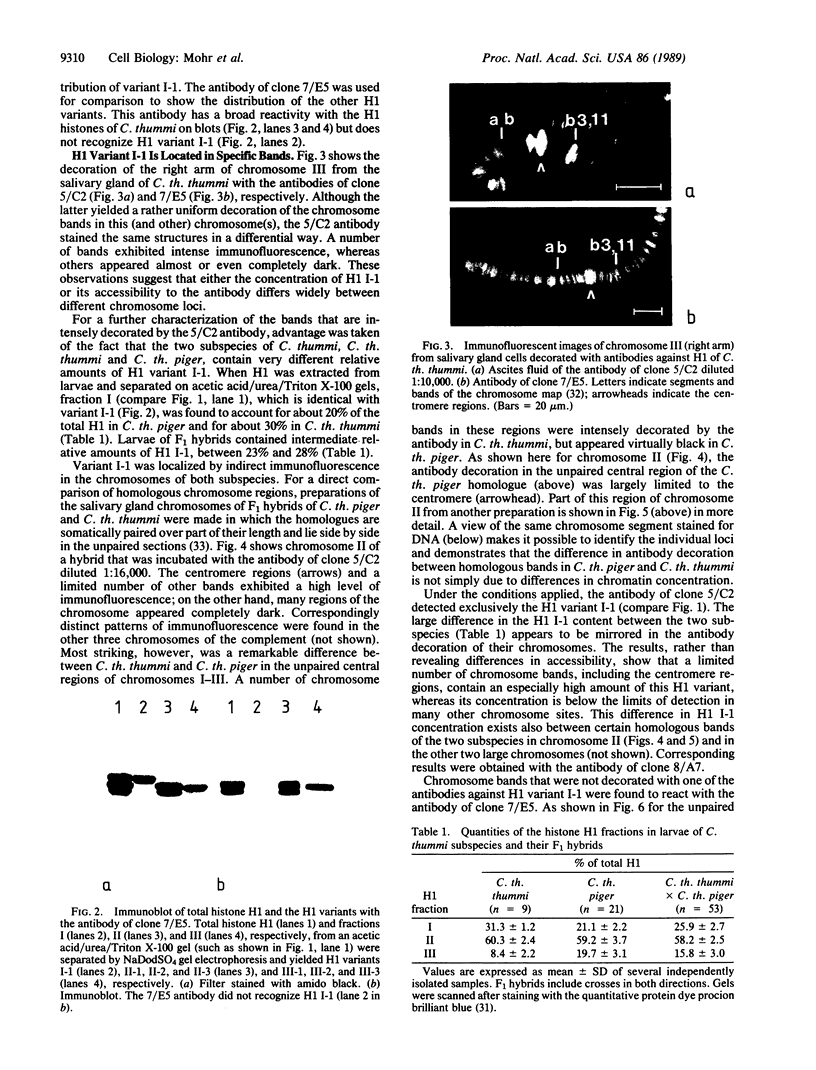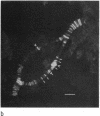Abstract
Chromatin of Chironomus thummi (Diptera) contains seven sequence variants of histone H1. A structurally divergent H1, variant I-1, accounts for about 20% of the total H1 in C. th. piger and for about 30% in C. th. thummi. Monoclonal antibodies against this protein have been induced and have revealed its restriction to the centromeres and to a limited number of other bands in the salivary gland chromosomes. Indirect immunofluorescence of the somatically paired homologous chromosomes of F1 hybrids indicates that the difference between the two subspecies in H1 I-1 content largely depends on differences situated at a number of distinct homologous chromosome bands. These bands were intensely decorated by antibodies against H1 I-1 in C. th. thummi but appeared virtually black in C. th. piger. The same bands, however, were decorated equally in both subspecies by an antibody that reacts with other H1 variants but does not recognize H1 I-1 and by a polyclonal anti-H1 antibody. The results suggest that H1 variant I-1 is characteristic of a specific type of chromatin that is confined to distinct chromosome segments and that is more frequent in the subspecies C. th. thummi, which has a 27% larger genome.
Full text
PDF




Images in this article
Selected References
These references are in PubMed. This may not be the complete list of references from this article.
- Allis C. D., Glover C. V., Gorovsky M. A. Micronuclei of Tetrahymena contain two types of histone H3. Proc Natl Acad Sci U S A. 1979 Oct;76(10):4857–4861. doi: 10.1073/pnas.76.10.4857. [DOI] [PMC free article] [PubMed] [Google Scholar]
- Branson R. E., Grimes S. R., Jr, Yonuschot G., Irvin J. L. The histones of rat testis. Arch Biochem Biophys. 1975 Jun;168(2):403–412. doi: 10.1016/0003-9861(75)90269-6. [DOI] [PubMed] [Google Scholar]
- Cole R. D. A minireview of microheterogeneity in H1 histone and its possible significance. Anal Biochem. 1984 Jan;136(1):24–30. doi: 10.1016/0003-2697(84)90303-8. [DOI] [PubMed] [Google Scholar]
- Engvall E., Perlmann P. Enzyme-linked immunosorbent assay, Elisa. 3. Quantitation of specific antibodies by enzyme-labeled anti-immunoglobulin in antigen-coated tubes. J Immunol. 1972 Jul;109(1):129–135. [PubMed] [Google Scholar]
- Gallati H., Brodbeck H. Peroxidase aus Meerrettich: Reagens zum Abstoppen der katalytischen Umsetzung der Substrate H2O2 und 2,2'-Azino-di(3-ethyl-benzthiazolinsulfonsäure-(6)) (ABTS). J Clin Chem Clin Biochem. 1982 Oct;20(10):757–760. [PubMed] [Google Scholar]
- Gallati H. Peroxidase aus Meerrettich: Kinetische Studien sowie Optimierung der Aktivitätsbestimmung mit den Substraten H2O2 und 2,2'-Azino-di-(3-ethyl-benzthiazolinsulfonsäure-(6)) (ABTS). J Clin Chem Clin Biochem. 1979 Jan;17(1):1–7. [PubMed] [Google Scholar]
- Hawkes R., Niday E., Gordon J. A dot-immunobinding assay for monoclonal and other antibodies. Anal Biochem. 1982 Jan 1;119(1):142–147. doi: 10.1016/0003-2697(82)90677-7. [DOI] [PubMed] [Google Scholar]
- Hoyer-Fender S., Grossbach U. Histone H1 heterogeneity in the midge, Chironomus thummi. Structural comparison of the H1 variants in an organism where their intrachromosomal localization is possible. Eur J Biochem. 1988 Sep 1;176(1):139–152. doi: 10.1111/j.1432-1033.1988.tb14261.x. [DOI] [PubMed] [Google Scholar]
- Hägele K. Differential staining of polytene chromosome bands in Chironomus by Giemsa banding methods. Chromosoma. 1977 Feb 3;59(3):207–216. doi: 10.1007/BF00292778. [DOI] [PubMed] [Google Scholar]
- KEYL H. G. Untersuchungen am Karyotypus von Chironomus thummi. I. Karte der Speicheldrüsen-Chromosomen von Chironomus thummi thummi und die cytologische Differenzierung der Subspezies Ch. th. thummi und Ch. th. piger. Chromosoma. 1957;8(6):739–756. [PubMed] [Google Scholar]
- Kearney J. F., Radbruch A., Liesegang B., Rajewsky K. A new mouse myeloma cell line that has lost immunoglobulin expression but permits the construction of antibody-secreting hybrid cell lines. J Immunol. 1979 Oct;123(4):1548–1550. [PubMed] [Google Scholar]
- Keyl H. G. Duplikationen von Untereinheiten der Chromosomalen DNS während der Evolution von Chironomus thummi. Chromosoma. 1965;17(2):139–180. doi: 10.1007/BF00330079. [DOI] [PubMed] [Google Scholar]
- Kistler W. S., Geroch M. E. An unusual pattern of lysine rich histone components is associated with spermatogenesis in rat testis. Biochem Biophys Res Commun. 1975 Mar 17;63(2):378–384. doi: 10.1016/0006-291x(75)90699-3. [DOI] [PubMed] [Google Scholar]
- Köhler G., Milstein C. Continuous cultures of fused cells secreting antibody of predefined specificity. Nature. 1975 Aug 7;256(5517):495–497. doi: 10.1038/256495a0. [DOI] [PubMed] [Google Scholar]
- Laemmli U. K. Cleavage of structural proteins during the assembly of the head of bacteriophage T4. Nature. 1970 Aug 15;227(5259):680–685. doi: 10.1038/227680a0. [DOI] [PubMed] [Google Scholar]
- Moss B. A., Joyce W. G., Ingram V. M. Histones in chick embryonic erythropoiesis. J Biol Chem. 1973 Feb 10;248(3):1025–1031. [PubMed] [Google Scholar]
- NEELIN J. M., BUTLER G. C. A comparison of histones from chicken tissues by zone electrophoresis in starch gel. Can J Biochem Physiol. 1961 Mar;39:485–491. doi: 10.1139/o61-046. [DOI] [PubMed] [Google Scholar]
- Robert M. Isolation and manipulation of salivary gland nuclei and chromosomes. Methods Cell Biol. 1975;9(0):377–390. doi: 10.1016/s0091-679x(08)60083-7. [DOI] [PubMed] [Google Scholar]
- Schmidt E. R. Clustered and interspersed repetitive DNA sequence family of Chironomus. The nucleotide sequence of the Cla-elements and of various flanking sequences. J Mol Biol. 1984 Sep 5;178(1):1–15. doi: 10.1016/0022-2836(84)90227-4. [DOI] [PubMed] [Google Scholar]
- Shires A., Carpenter M. P., Chalkley R. New histones found in mature mammalian testes. Proc Natl Acad Sci U S A. 1975 Jul;72(7):2714–2718. doi: 10.1073/pnas.72.7.2714. [DOI] [PMC free article] [PubMed] [Google Scholar]
- Stollar B. D., Ward M. Rabbit antibodies to histone fractions as specific reagents for preparative and comparative studies. J Biol Chem. 1970 Mar 25;245(6):1261–1266. [PubMed] [Google Scholar]
- Towbin H., Staehelin T., Gordon J. Electrophoretic transfer of proteins from polyacrylamide gels to nitrocellulose sheets: procedure and some applications. Proc Natl Acad Sci U S A. 1979 Sep;76(9):4350–4354. doi: 10.1073/pnas.76.9.4350. [DOI] [PMC free article] [PubMed] [Google Scholar]
- Tsai Y. H., Hnilica L. S. Tissue-specific histones in the erythrocytes of chicken and turtle. Exp Cell Res. 1975 Mar 1;91(1):107–112. doi: 10.1016/0014-4827(75)90147-0. [DOI] [PubMed] [Google Scholar]
- Westermann R., Grossbach U. Localization of nuclear proteins related to high mobility group protein 14 (HMG 14) in polytene chromosomes. Chromosoma. 1984;90(5):355–365. doi: 10.1007/BF00294162. [DOI] [PubMed] [Google Scholar]
- Wu R. S., Panusz H. T., Hatch C. L., Bonner W. M. Histones and their modifications. CRC Crit Rev Biochem. 1986;20(2):201–263. doi: 10.3109/10409238609083735. [DOI] [PubMed] [Google Scholar]









